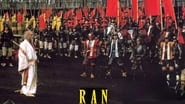Anssi Vartiainen
Akira Kurosawa returns to Shakespeare in this loose adaptation of King Lear that also incorporates elements from the legends of the daimyō Mōri Motonari. Or perhaps it would be more accurate to say that those two sources are eerily similar. An aging warlord (Tatsuya Nakadai) that has decided to retire and hand over the three great castles he has conquered during his bloody reign to his three sons, with the oldest named his successor and the head of the great house. But almost immediately the sons begin arguing among one another and soon the warlord finds himself dethroned and wandering the battlefields of the war his sons are waging.Quite like with his previous Shakespeare adaptation, Throne of Blood, Kurosawa delves deep into man's corruptibility and the taint of power in this film. Many of his films are at least somewhat heroic in nature and tone. Whereas the protagonist of this film, the warlord, is anything but. We learn throughout the course of the film that his life is a long tale of conquest, beaten down enemies, blood, fire and destruction. Yet Kurosawa achieves the very hard task of making him sympathetic despite all that. He obviously loves his sons and his anguish at seeing his life's work torn down in a matter of days is real and jarring.Perhaps it could even be said that his character is reflected in his sons. There's the oldest, the one with the power, pride and possessions, but who is brought low by those closest to him and stands on feet of clay. There's the schemer, the one willing to commit atrocities to get what he wants. And there's the youngest, who's the most driven by the love he has for his family, but who's also the one with the most difficulties in surviving the war-torn realm they live in.The film is also massive in scope, budget and length. Its themes are deep, its running time is closer to three hours and its story is a humongous five act monstrosity. It was also the most expensive Japanese film ever made back then and the money is definitely on the screen. Hundreds of soldiers at once on display, all of them decked in armour. Entire castles built and then destroyed. Lavish costumes, ruins and locations. I don't think I've seen a movie with this much handcraft on the screen since The Lord of the Rings trilogy. And this predates those films by almost two decades.Yet the film is always gripping, always interesting and endlessly fascinating. It's called one of Kurosawa's finest, and yeah, I can see why.
sir-mauri
An absolute masterwork, the human being's dark sides as the main protagonists. Vengeance, hatred, betrayal, greed and what they bring with themselves. It's the deepest film that I've seen so far on Kurosawa's filmography. Visually beautiful, pure poetry in every frame and every death. There is strong symbolism on the red color and the fire. The history of humanity has been covered by blood and fueled with greed since the very beginning, among these beautiful landscapes, the human race have been destroying themselves no matter the family bond or friendship. Not only Kurosawa's best, but also the best film adaptation of Shakespeare.
SnoopyStyle
Warlord Hidetora Ichimonji is haunted. He divides his kingdom among his three sons; Taro, Jiro, and Saburo. The oldest Taro is given the First Castle to lead the younger brothers. The youngest Saburo objects and he is banished. Another lord Fujimaki takes him in and offers his daughter for marriage. Taro's wife Lady Kaede lost her blood family to Hidetora's ruthless conquest and plots to destroy the family from within. Taro and Jiro force Hidetora from power driving him to madness.Legendary director Akira Kurosawa delivers a big production of mass battles and epic drama. It's one of the grandest samurai epics. It is wonderfully beautiful. The acting is big. It is visually stunning.
WILLIAM FLANIGAN
Viewed on DVD. Costumes/makeup = ten (10) stars; restoration = ten (10) stars; score = nine (9) stars; set/decoration = nine (9) stars; sound = five (5) stars. Today's mega-budgeted, tent-pole films consist of spectacular, computer-generated technical set pieces strung together like beads on an extremely thin (or near nonexistent) plot string. Director Akira Kurosawa has employed a similar approach here. There are two major technical beads on his string (and a fair number of minor ones). One of the majors is presented in the opening scenes where costumes (and actors' makeup) are overwhelming spectacular and, perhaps, the most gorgeous ever filmed for a samurai-like movie. The other major technical set piece occurs in the closing scenes of intricate military maneuvers by huge (some real, some not) armies. The plot string is excessively stretched/padded-out as well as twisted up and knotted to the point of numbing confusion. (I am not a fan of voice overs, but this is one film that could really use one!) Acting is hammy and sometimes ludicrous (a Kurosawa trademark) with characters using dialog styles that are often challenging to comprehend even with the subtitles turned on (another Kurosawa trademark). Some sound dubbing is poorly executed with outdoor scenes sounding like they were recorded in an echo chamber. Sets (indoor and out) are/appear completely authentic (filming occurred around and inside the most spectacular extant castles in Japan (except for the royal family's). Stunt work is curious with each stunt fall from a horse looking pretty much identical (same stunt person each time or reuse of the same filmed sequence?). Viewers who are riders will find mounting a horse on the right especially interesting. Camera format could have greatly benefited from a much wider aspect ratio to engender a more epic feel. Film score is rich and integrates well with scenes. Restoration is outstanding. Bottom-line: This is an overly long in effect documentary on some of the technical aspects of making a movie masquerading as a movie. WILLIAM FLANIGAN, PhD.






